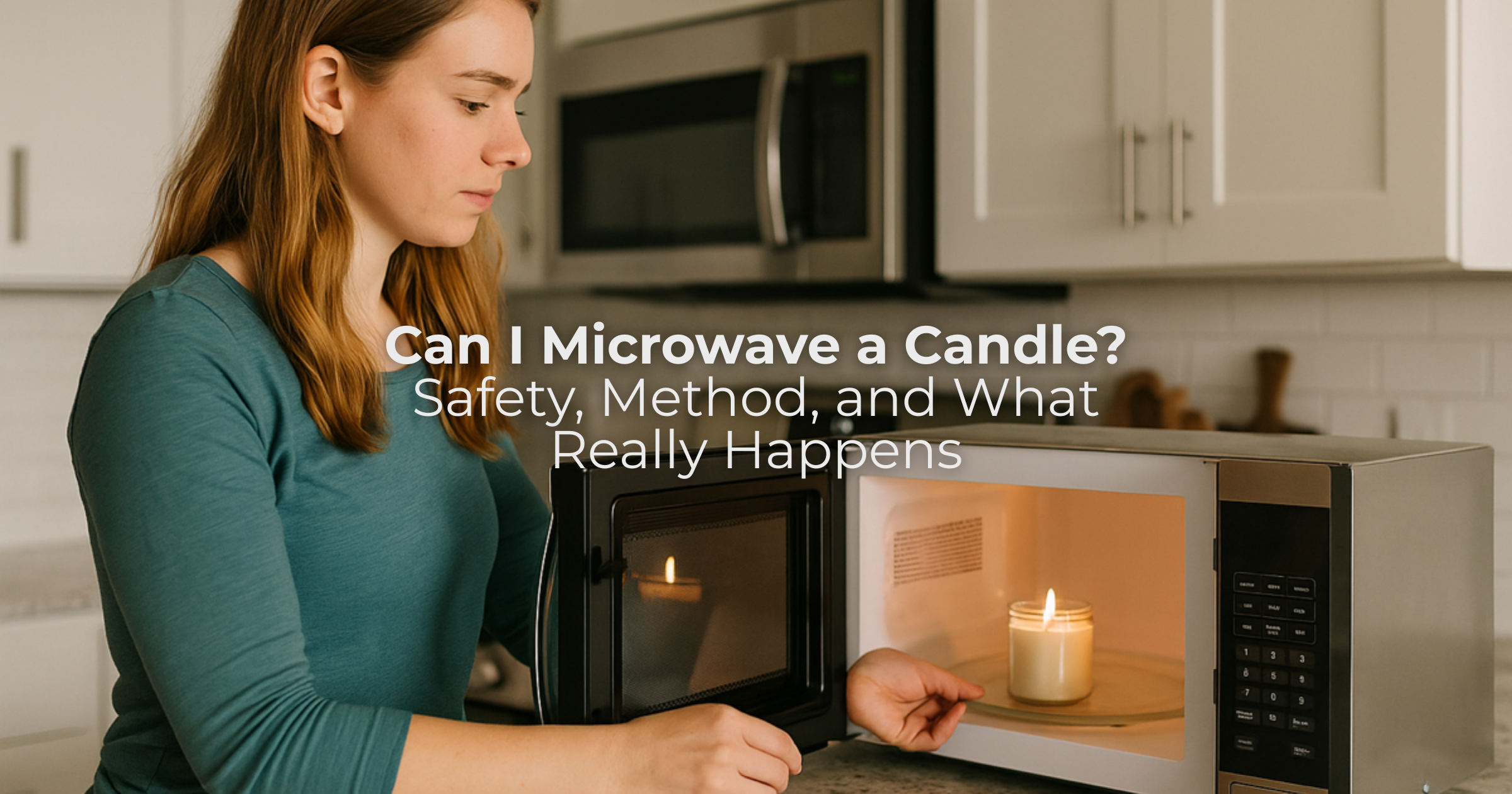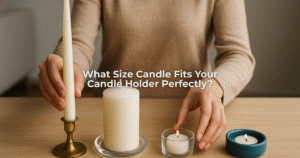No products in the cart.
Can I Microwave a Candle? Safety, Method, and What Really Happens

People search “can I microwave a candle” when they want a fast fix or to remelt leftover wax. I’ve tested soy, paraffin, and beeswax in real kitchens with real glass candle jars and a regular microwave oven.
This guide shows what actually happens to wax under microwave heat, when it stays safe, and when it turns risky.
You’ll learn clear steps to melt small amounts the right way, the temperatures to watch, how to prevent hot wax splatter, and how to protect your container and wick.
Read on for practical, tested advice you can follow with a microwave-safe container and simple tools.
Can You Microwave a Candle Safely?
Yes, you can microwave a candle, but only if you do it carefully using a microwave-safe container and short heating intervals.
Microwaving wax requires close monitoring because wax melts unevenly and can overheat, causing cracked containers, smoke, or even a fire hazard.
Always remove any metal parts, use a heat-resistant glass or ceramic bowl, and heat in short bursts while stirring between intervals.
This method works safely for remelting or fixing candles only when you control the temperature and avoid overheating.
Since candles already account for about 3% of home fire deaths and 6% of home fire injuries, even small mistakes like leaving the wax unattended or using the wrong jar can become dangerous.
Always remove any metal wick base or decorative element, and heat the wax in short bursts, stirring between each interval. Proper heat control prevents fire hazards, chemical fumes, and container failure.
What Happens When You Microwave Candle Wax?
Microwaving wax sounds simple until you see what really happens inside that container. Unlike a double boiler, which spreads heat gradually through conduction, a microwave oven creates uneven heating patterns.
The wax begins to liquefy near the surface while the inner portion remains solid. As these two zones collide, trapped air pockets expand, producing small pops or bubbles. That’s how hot wax splatter and wax residue can form on the microwave turntable.
Each wax type behaves differently. Soy wax melts smoothly but tends to hold air, while paraffin wax softens faster and may reach a wax overheating point if not stirred.
Beeswax, being denser, resists quick melting and can form vaporized scent molecules when pushed past its ideal temperature range.
If overheated, fragrance oils separate from the base wax, a process called wax phase separation, which weakens scent throw and alters texture once it cools.
This inconsistency can also shift the wick holder or cause wick displacement from liquefaction, making the candle unusable without re-centering.
In rare cases, you may even notice faint wax smoke release or a soot residue smell if the wax begins to burn microscopically.
All these effects arise from one source: uneven energy absorption that the microwave cannot balance.
How to Microwave a Candle the Right Way?
When I remelt wax for testing fragrance blends, I never heat it all at once. The safest way is to control time and power carefully.
First, remove any cotton wick, metal base, or decorative item. Place the wax into a microwave-safe container—preferably a thick glass bowl or heat-resistant cup—and avoid plastic, which can warp or leach chemicals.
Set the microwave on low or medium power. Heat in short bursts of 15 to 30 seconds. After each interval, stir gently using a wooden stick or thermometer probe to equalize temperature.
This distributes heat evenly and prevents localized hotspots that might cause a rapid ignition under heat radiation. Continue until the wax reaches a smooth, liquid consistency without boiling.
If you have a thermometer, monitor the temperature closely. Most waxes melt between 50°C and 80°C, depending on composition.
Stop immediately if the surface starts smoking or bubbling. Leaving wax unattended for even a few seconds can escalate into microwave sparking or glass shattering due to internal stress.
Finally, wipe any spilled wax before it solidifies, as hardened residue can damage the turntable surface or interfere with later heating cycles.
Following these steps keeps both the microwave-safe bowl and your wax intact.
What Precautions Should You Take Before Microwaving a Candle?
Before you put any candle in a microwave, preparation determines safety. Start by checking the container. Only use microwave-safe containers, thick glass or ceramic that can handle direct heat. Avoid anything with metallic paint, foil labels, or exposed metal wicks. Even a tiny metal clip can trigger microwave electromagnetic interference and spark inside the chamber.
Position the container at the center of the microwave turntable to ensure even rotation. This reduces uneven heating and prevents localized thermal hotspots.
Place a paper towel or plate underneath to catch any overflow. Keep your face away when opening the microwave door, as trapped heat may cause a sudden puff of vapor.
Never attempt to melt wax that already shows signs of contamination or previous burning. Residual carbon and fragrance oils can create chemical fumes or release soot residue.
Also, limit heating to small quantities melting large wax blocks increases fire risk and the chance of air pocket explosions.
Once melted, let the wax rest for a few minutes before handling. Liquid wax retains heat longer than it appears.
Always use oven gloves or tongs when removing the heat-resistant cup. Accidents often occur not during melting but when people rush the cooling process.
Final Thoughts
Microwaving a candle is possible, but it demands control and awareness. The key is understanding that wax isn’t water—it doesn’t heat uniformly.
Treat it like a delicate ingredient, not something to rush. When done correctly, microwaving can be useful for small repairs, repouring leftover wax, or testing fragrance blends.
When done carelessly, it can turn into a fire hazard or damage your equipment.
Over years of experimenting with soy wax, paraffin, and beeswax, I’ve learned that patience is the single most important factor.
Heating wax slowly, stirring often, and keeping an eye on texture prevents every major problem from loss of fragrance to cracked containers.
If your passion lies not just in melting wax but in enjoying high-quality candles made the right way, explore Karigar Style.

Nav Preet is the founder and creative soul behind Karigar Candles. Inspired by heritage, nature, and the warmth of handmade artistry, she crafts candles that do more than glow—they evoke emotion. Through this blog, she shares her love for scents, styling, and mindful living, one flame at a time.
Creative Head at Karigar Style






